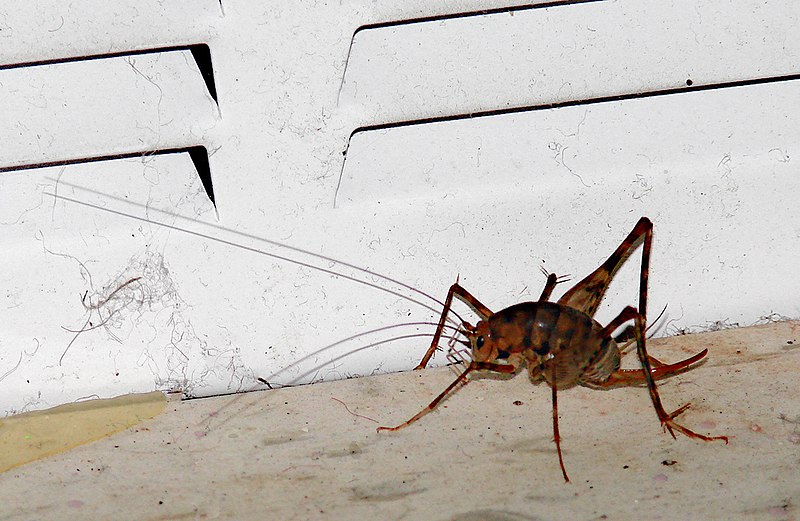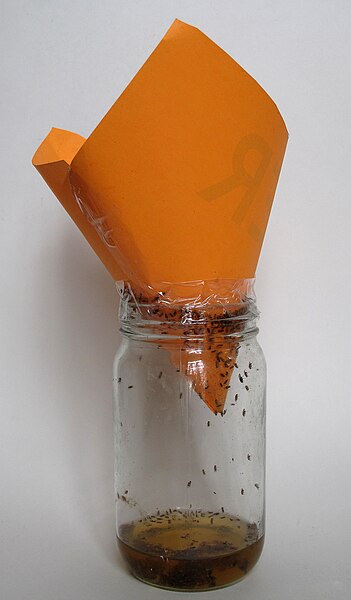 Almost every zoo building in which I’ve worked was home to roach (2-3 species) and House Cricket populations. In most, pesticide use was not an option. An older animal keeper whom I befriended let me in on his favorite insect pest control technique – the molasses trap. He was content to let management wonder how he did such a good job so, out of respect for him, I did not share the secret until he retired. Then, for a time, molasses traps became standard in several zoo buildings. Molasses is also useful in outdoor traps, where it never fails to turn up a variety of interesting species. I’ll expand on that below as well.
Almost every zoo building in which I’ve worked was home to roach (2-3 species) and House Cricket populations. In most, pesticide use was not an option. An older animal keeper whom I befriended let me in on his favorite insect pest control technique – the molasses trap. He was content to let management wonder how he did such a good job so, out of respect for him, I did not share the secret until he retired. Then, for a time, molasses traps became standard in several zoo buildings. Molasses is also useful in outdoor traps, where it never fails to turn up a variety of interesting species. I’ll expand on that below as well.
Pesticide Problems
House Crickets, roaches and other escaped “feeder insects” can be problematic in private collections. In the damp basements favored by amphibian keepers, Spotted Camel Crickets (Ceuthophilus maculatus, please see photo) may also set up housekeeping. These unusual creatures are very interesting in their own right, and I’ve featured them, and a large African relative, in several exhibits. However, most folks find their size, appearance and jumping abilities quite unsettling (please see comments in the article linked below – insect fans will find them very interesting!).
Crickets usually succumb to appropriate pesticides, but roaches often develop immunities. In any event, sprayed pesticides are dangerous to both people and their animal collections. Powders and baits also have downsides. Insects travel widely, and while doing so may track powder-based pesticides into terrariums or across supplies (roaches moving between cages have been implicated in the spread of Salmonella in several zoo-based studies). Those that enter enclosures may be consumed by insectivorous pets, raising the danger of secondary poisoning.
Using Molasses Traps
A molasses trap is simply a jar or other container partially filled with molasses and leaned against a wall or other surface that provides access. Molasses’ scent apparently carries far, and is irresistible to many insects; certainly it draws crickets and roaches very quickly. I’ve even sat in the dark in various zoo holding areas to watch the effects of a molasses trap, and was amazed at how rapidly insects responded. Those that enter the trap sink into the molasses and perish in “La Brea Tar Pit style”.
If a rough wall or other climbable surface is not handy, simply wrap a rag around the molasses container so that insects are able to scale its sides. Armed only with this simple technique, I’ve rid quite sizable exhibits, holding rooms and basements of established roach and cricket populations.
Glue Traps
Molasses can also be used to lure roaches and crickets onto glue traps, but most remain alive for some time. Killing the trapped insects, as I preferred to do when glue traps were in use, is very time consuming. Molasses jars eliminate this concern.
Ants
Interestingly, ants (at least Pharaoh Ants and other species I’ve had experience with) seem easily able to evade death-by-molasses. I’ve watched them hang onto the sides of a jar and eat their fill, then simply back up, turn around, and head off to distribute the treat among their colony-mates! I’m sure that someone more imaginative than I can tweak the technique and render it effective against ants…please write in if you have any thoughts on this and I’ll be sure to share your ideas with other readers.
Observing and Collecting Native Insects
 Molasses, especially if mixed with beer, will attract a wide variety of beetles, moths, bees, wasps and other insects. Entomologists have long used it to sample wild populations, occasionally discovering a new species in the process. If allowed access to the bait, as described above, the insects will perish. If you wish to collect living insects, install a cloth or fine screen barrier above the bait.
Molasses, especially if mixed with beer, will attract a wide variety of beetles, moths, bees, wasps and other insects. Entomologists have long used it to sample wild populations, occasionally discovering a new species in the process. If allowed access to the bait, as described above, the insects will perish. If you wish to collect living insects, install a cloth or fine screen barrier above the bait.
I’ve painted molasses on tree trunks, and was usually rewarded with an array of interesting visitors, including (in NY) several long-horned beetles and moths that were new to me. Please see the Mississippi Entomological Museum article below for detailed (detailed as in “which type of Keebler cookie is best for specific ant species”!) bait and trapping ideas.
The Zoo Med Bug Napper is a light-based trap that can be used to collect moths, beetles, crane flies and other flying insects.
Further Reading
Environmentally-Friendly Insect Control
Insect Traps and Baits (tips for collectors)
Fly trap image referenced from wikipedia and originally posted by Downtowngal
 That Reptile Blog – Reptile, Amphibian and Exotic Pet Care and Information
That Reptile Blog – Reptile, Amphibian and Exotic Pet Care and Information



‘Sweet’article
Thanks again
Hi Scott,
Thanks for the kind words, Best, Frank
Thanks for another great blog, Frank. You didn’t mention it specifically, but this is also a GREAT option for keepers of tarantulas (and other invertebrates) where the use of pesticides is absolutely contraindicated. Thanks for sharing!
Hello Brad
Thanks for your interest and kind words; I should have specifically mentioned inverts as well. I’m posing on on some invert-interest sites, and will be clearer.
Good luck, enjoy and please keep me posted.
Best regards, Frank Indiviglio.
Hello Frank
Have you heard of anyone culturing camel crickets? They seem like they’d be the perfect prey for some things(esp. whipscorpions).
Also-they don’t chirp!
~Joseph
Hi Joseph,
I thought you might write in…you have a good eye for the odd and interesting! The Spotted Camel Cricket bred in a large exhibit I had for them; uneaten individuals (I fed them to large lizards; removed the back legs, however, before feeding to frogs) also established themselves in exhibits from time to time. I wasn’t able to track what was going on due to the size of the exhibits; adults likely prey upon eggs and young, however. Several zoos have kept larger species from time to time, Cincinnati did well with one, sent a group to me years ago. Unfortunately, my responsibilities changed at the time and I lost track of them; they did not do very well, I learned later.
I think the key would be either a huge enclosure with plenty of substrate, etc., so the eggs/young can escape adults or, as with house crickets, providing containers of soil for eggs, and removing these regularly.
They do well on tropical fish food, fruits and vegetables, and damp leaf litter.
Maybe the “next super mealworm”?!
Best, Frank
Not gonna lie crickets scare the hell out of me but I do find them rather interesting
Hi Dirk,
They can be very interesting…even chivalrous, according to this article!. As for the ultimate “nightmare cricket”, check out this Giant Weta of N. Zealand, the world’s heaviest insect.
Hi Frank, how do you care for camel crickets?
Hi Jordan,
They need a fairly humid environment, eat almost anything but higher protein requirements than domestic crickets…moist dog food, tropical fish flakes added to cricket chow, fruit, etc; provide lots of hiding spots, cardboard rolls etc on which to climb. Like house crickets, they consume their eggs and so can be tricky to breed in numbers. best,. Frank